
Anatomy of a Rover
In January 2004, Spirit and Opportunity, two
identical robotic rovers, entered the martian atmosphere and
landed after a seven-month journey from Earth. By the time "Is
There Life on Mars?" aired on December 30, 2008, both
sojourners had explored their respective landing areas for
nearly five years, almost 20 times longer than NASA had
planned for at a minimum. The twin rovers have made one
intriguing discovery after another, and they appear to be
still going strong despite creeping signs of old age. Below,
learn more about this hardy pair of robotic geologists and
their sophisticated scientific instruments.—Lexi Krock

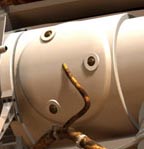
|
|
Mini-TES
The Miniature Thermal Emission Spectrometer is housed
inside the heated main body of the MER, but it uses the
rover's long neck as a periscope from which to look out
and build a detailed panoramic image of the surrounding
area. With infrared light, Mini-TES penetrates martian
surface dust to create a map of telltale heat signatures
from rocks and soil, searching for types and
concentrations of minerals that suggest formation by
water. Mission scientists use data from the Mini-TES and
MER's other panoramic cameras to choose potential
scientific targets in the landscape.
|
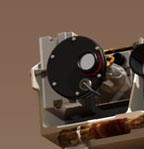
|
|
Pancam
MER uses its twin Pancams to shoot 360° images of
its surroundings, which help mission controllers
determine where MER will go to make closer inspections.
MER's pair of panoramic cameras look and function like
eyes. Their resolution and field of view mimic human
vision, making them the most advanced color imaging
system ever sent to another planet. The Pancams can
rotate in a complete circle on their long, neck-like
mast and can swing up to 180° up or down. More than
a dozen filters allow for imaging across every possible
wavelength of light.
|
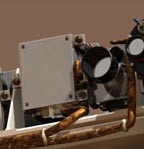
|
|
Navcam
One of two kinds of non-scientific panoramic cameras
aboard MER, two stereo Navcams help mission engineers
back on Earth get a visual impression of MER's
surroundings in black-and-white. MER navigates on its
own part of the time, making computer-generated
decisions about where and how to move about the martian
landscape per mission control's daily set of general
specifications. The Navcam provides engineers with a
means of visually tuning in as MER carries out their
commands—though not in real time, because of the
tens-of-minutes lag time in sending and receiving
communications between Earth and Mars.
|
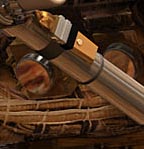
|
|
Hazcam
Two pairs of hazard avoidance cameras located at MER's
front and back are designed to support the rover's
automated navigation, scanning the immediate landscape
for obstacles that may hinder or damage it. Working in
tandem with the rover's computer software, the Hazcams
are one of the keys to MER's ability to make intelligent
choices about getting around hazardous features on the
martian surface. While the rover moves at up to two
inches per second on flat, hard terrain, under automated
control with hazard avoidance in action, it can achieve
only about one-fifth of that speed.
|
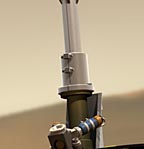
|
|
Low Gain Antenna
Also called the UHF Relay Antenna, this close-range
antenna transmits signals between MER and two orbiting
spacecraft, Mars Global Surveyor and Mars Odyssey, using
technology analogous to that of a walkie-talkie. After
Surveyor or Odyssey receives information from either of
the MERs, it will act as a satellite, relaying
information back to Earth using its own communication
system. The MER also sports a smaller UHF antenna (not
shown here) whose express purpose is to relay signals
detailing the rover's mechanical health via the
spacecraft satellite network to mission operations.
|
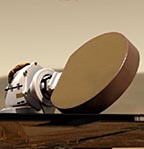
|
|
High Gain Antenna
At its tail end, MER is equipped with a communications
dish that can point itself in the direction of Earth and
beam signals directly to the three massive radio
antennas of NASA's international Deep Space Network,
located in California's Mojave Desert; near Madrid,
Spain; and near Canberra, Australia. MER's High Gain
Antenna can both send and receive signals related to the
rover's scientific work or its general performance. With
this steerable antenna, MER does not have to move in
order to communicate directly with Earth, which saves
precious energy for other tasks.
|
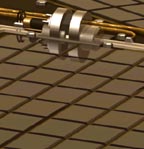
|
|
Solar Arrays
What look like shiny, black wings attached to MER's core
body are its main source of power, a suite of solar
panels that can fuel its movements and recharge its two
night-use batteries during the day. The solar arrays
were designed to generate about 140 watts of power for
up to four hours per day—plenty of energy for all
the rover's functions. Eventually, however (mission
scientists can't predict when), seasonal sunlight
changes and a layer of martian dust that will have
settled on the arrays will prevent them from generating
more than about 50 watts per day, too little power for
the rover to drive.
|

|
|
In Situ Instruments
MER carries four scientific tools at the tip of a
concealed robotic arm that can extend to examine an
interesting rock or patch of soil. The Rock Abrasion
Tool located here is a powerful grinder that can quickly
penetrate a stone's outer layer, creating a hole two
inches wide and one fifth of an inch deep that is ready
to be analyzed by one of the other three tools on the
rover's arm, the Microscopic Imager (MI), the
Mössbauer Spectrometer (MS), or the Alpha-Particle
X-Ray Spectrometer (APXS). The MI is a specialized
camera that will create the closest views of martian
rocks and soils ever obtained, highlighting tiny visual
details in their compositions that may provide evidence
of ancient waterborne sediments. The MS studies minerals
that contain iron, which is abundant on Mars. Each MS
measurement takes 12 hours to complete but can determine
the exact chemical composition of iron-bearing minerals,
which may hold clues to Mars' early environment. The
APXS complements the Mössbauer tool by measuring
alpha particles and X-ray emissions in the same samples,
yielding further information about their origin and
history.
|
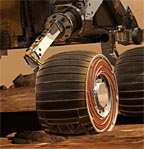
|
|
Rocker-Bogie Mobility System
Each MER has already traveled several thousand feet
across the surface of Mars. Doing one better than the
average S.U.V., the rovers will take on the martian
landscape with six-wheel drive plus a specialized
suspension system that bends at its joints instead of
using springs. NASA's Jet Propulsion Laboratory
developed this so-called Rocker-Bogie system to allow
MER to drive over rocks or ditches bigger than its
10-inch wheel diameter without overturning, one of the
mission's worst-case scenarios. The rover can withstand
tilting of up to 45° in any direction without
tipping over.
|

|
|
Warm Electronics Box (WEB)
An insulated container inside MER's undercarriage
protects the sensors and brains of its vital electronics
and batteries from extremely cold martian nighttime
temperatures, which can plummet to as low as -157°F
during part of the rovers' journey. With a combination
of electrically powered heaters, radioisotope heaters,
and heat from the humming electronics housed within, the
WEB provides a continuously temperate environment for
MER's most sensitive technologies, those incapable of
operating below -67°F.
|
|


We recommend you visit the
interactive version. The text to the left is provided for printing purposes.
|













